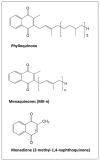Vitamin K and bone
- PMID: 29263734
- PMCID: PMC5726210
- DOI: 10.11138/ccmbm/2017.14.1.200
Vitamin K and bone
Abstract
Vitamin K is mainly known as an agent involved in blood coagulation, maintaining the activity of coagulation factors in the liver. In addition, epidemiological studies suggested that a lack of vitamin K is associated with several diseases, including osteoporosis and vascular calcification. There are two main kinds of vitamin K: Phylloquinone (or PK) and Menaquinones (MKn), both act as co-enzyme of y-glutamyl carboxylase (GGCX) transforming under-carboxylated in carboxylated vitamin K dependent proteins, such as Bone Gla Protein (or Osteocalcin) and Matrix Gla Protein. Recently, Vitamin K was also identified as a ligand of the nuclear steroid and xenobiotic receptor (SXR) (in murine species Pregnane X Receptor: PXR), expressed in osteoblasts. The purpose of this literature review is to evaluate the protective role of Vitamin K in bone and vascular health.
Keywords: bone; fractures; vitamin D; vitamin K.
Figures



References
-
- Shearer MJ, Newman P. Metabolism and cell biology of vitamin K. Thromb Haemost. 2008;100:530e47. - PubMed
-
- Booth SL, Martini L, Peterson JW, Saltzman E, Dallal GE, Wood RJ. Dietary phylloquinone depletion and repletion in older women. J Nutr. 2003;133:2565–2569. - PubMed
-
- Schurgers LJ, Teunissen KJ, Hamulyak K, et al. Vitamin K-containing dietary supplements: comparison of synthetic vitamin K1 and natto-derived menaquinone-7. Blood. 2007;109:3279–3283. - PubMed
-
- Conly JM, Stein K. The production of menaquinones (vitamin K2) by intestinal bacteria and their role in maintaining coagulation homeostasis. Prog Food Nutr Sci. 1992;16:307–343. - PubMed
Publication types
LinkOut - more resources
Full Text Sources
Other Literature Sources
